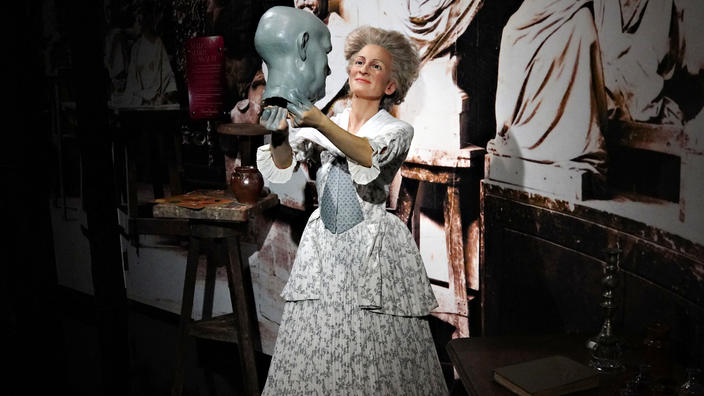The wax effigies exhibited in the Madame Tussauds museum in London and in its countless international branches cause some people to feel deeply uneasy.
The more or less happy resemblance of the sculptures with the stars and the personalities whose features they copy can disturb, disturb.
Suffice to say that the at least macabre origins of the first replicas formed by Marie Tussaud (1761-1850) are unlikely to reconcile the most reluctant to her galleries with a thousand faces.
Read alsoA Madame Tussauds museum in Dubai, the first in the Arab world
Because before making the delights of London, where she founded in 1835 the first wax museum in her name, Madame Tussaud worked, in her youth, in the office of the sculptor and anatomist Philippe Curtius. Trained, on the Boulevard du Temple, in the art of forming wax figures, of shaping the faces and mannequins of Parisian personalities, Marie Tussaud went through the period of the French Revolution not without difficulty. Stopped for a while, she began to work on the death masks of the victims of the time. The precise extent of the masks produced at this time is not well known. A few years later, the bloody faces of the figures of the Revolution, however, pile up inside the sinister
"Chamber of Horrors",
that Madame Tussaud opens in her London museum.
Louis XVI, Marie-Antoinette, Marat, Robespierre,… The legend tells then that she would have modeled on the spot these heads freshly passed over the guillotine - or the dagger, in the case of Marat.
Greedy Morbidity
The sulphurous word that attracts shiver-loving Londoners to Madame Tussauds ensures the success of the Frenchwoman.
She also capitalizes there on the fascination exerted across the Channel by the figure of Napoleon, which she observed first-hand during her first tour of the United Kingdom, in 1802. The sinister waxes exhibited in her museum in London, however, hold more significance. the macabre recreation of the historical vestige.
"It is highly unlikely that the founder really took 'on the spot' the prints of the heads of the victims of the guillotine exhibited in the museum"
, thus specified in 2011 the anthropologist Denis Vidal in a chapter of the collective work
Humains , non-humans
devoted to wax figures.
Likewise, most of the historical figures depicted there were more inspired by pre-existing drawings, paintings, sculptures or photographs. "
Read alsoThe Tussaud Museum in Berlin chooses its side and throws the wax statue of Donald Trump in the trash
This is the case with the so-called Robespierre death mask, kept at Madame Tussauds and a plaster copy of which was used as a model, in 2013, for the controversial reconstruction of the revolutionary's face.
"We have known for a long time that the" death mask "that the famous Mme Tussaud would have cast on the bloody head of the Incorruptible, on the evening of 10 Thermidor, is a fake, reconstituted a posteriori from portraits"
, had pleaded in the columns of
Figaro
historian Philippe Delorme. A position towards which also tend by the historians of the Revolution Hervé Leuwers and Guillaume Mazeau, who point moreover - in an article published in 2014 in the
Historical Annals of the French Revolution
- the not very credible nature of the
Mémoires
de Madame Tussaud, where she claims the production of the casting of Robespierre.
Marie Tussaud nonetheless remains at the origin of some real productions, collected under the generous forgery of the Revolution.
A copy of Marat's death mask, now kept at the Municipal Library of Lyon, would thus be from his work.
It would have been made for the painter Jacques-Louis David, close to the revolutionary.
The plaster object is far removed from the striking wax of the patient murdered in his bathtub, which was exhibited, from the 1830s, in the
London
“Chamber of Horrors”
.
Madame Tussaud has been criticized for a certain
"taste for sensationalism"
, recalls
National Geographic
.
This inclination was perhaps due to clairvoyance: almost two centuries after the inauguration of his museum, the thrill of the ghost train is still in full swing.








/cloudfront-eu-central-1.images.arcpublishing.com/prisa/KMEYMJKESBAZBE4MRBAM4TGHIQ.jpg)


